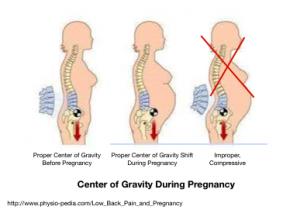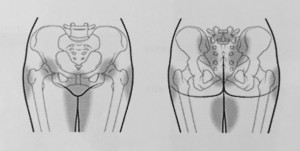by Jodie Isles | Remedial Massage Therapist
….I’m going to call it pregnancy triple P
So many women say:
“My hips and pelvis feel like they are “falling apart”, my hips just ache all the time or at night, when I walk my pelvis feels unstable and sore, and/or I have pain in the pubic area“.
For some women, it is a general dull ache, which after some changes to posture and positioning, exercise and massage it can be managed. For others, it can be quite debilitating, requiring specialist care.
Before we continue, any hip or pelvis pain should be checked firstly by your obstetrician, and then by a women’s health specialist such as a physiotherapist, osteopath or chiropractor. Proper diagnosis is essential. There are a number of things that can help, such as manual therapies by your specialist, massage, and using a pregnancy pelvic control belt. We have some very specific massage techniques we use to assist with reducing the muscle tension, and assisting to gently support and reduce strain to the ligaments which aide other specialist care.
So, let’s continue about you and your hip/pelvis pain ….
Pelvic pain is pain in your pelvic joints that may develop during or after pregnancy. It may be caused by:
- Changes to posture
- Increased pressure on the pelvis due to the growing baby
- Hormonal changes which soften the ligaments that support the pelvis
There are a number of hormonal changes during your pregnancy. One in particular, you have no doubt heard of, is Relaxin. It is a vital hormone for pregnancy responsible for supporting the uterus to remain at rest during your pregnancy, and for dilating the cervix during labour. It is also used to increase flexibility of the pubic symphysis and ligaments of the sacral joints.
Pelvic postural changes during pregnancy
Your pelvis has a lot of changes to accommodate the increasing size of the uterus and your baby.
During pregnancy and as your baby, & therefore uterus grows, it puts pressure on the pelvis to tip forward. The sacrum (the large, wedge shaped bone that sits at the base of our spine) has the tendency to tip forward to try to balance the load.
Think of this like a bowl sitting on a bench, if you put a load to the front of the bowl it will naturally tip forward and eventually spill the load. That’s what is happening to your pelvis, your baby is sitting at the front of the pelvis, causing your pelvis to tip forward and strain muscles, ligaments and associated joints. Ideally, we would like to see your baby sitting back into your pelvis, like this:
Physiotherapists specialising in pregnancy can help you with the right exercises to do at home to encourage the correct pelvic position and strengthen your core muscles in your abdomen to support this pelvic position.
What muscles are affected with the pelvic pain?
With the changes your posture, generally your lower back becomes more curved, and your mid back has to curve more the opposite way to balance you out. Because your pelvis tips forward, your quadriceps (muscles at the front of your thigh) generally become shorter and tighter, and your hamstrings (muscles at the back of your thigh) get tight as they are being lengthened.
Tightness can also occur in the Gluteals, hip flexors (one’s that bend your knees up, and help you touch your toes), adductors (your inner thigh), and lower back due to associated pelvis change.
What does pelvic pain feel like?
Pelvic Pain can feel like clicking or grinding of the pelvic joints; Or pain in the front, side or back of the pelvis, buttock, groin and possibly down to the thighs.
Most women complain about pain in one or more of these shaded areas:
What can make your pelvic pain worse?
- Prolonged walking
- Fast walking
- Getting in and out of the bed or car
- Rolling in bed
- Lying flat
- Deep squatting or lunging
- Standing on one leg (i.e getting dressed – putting on pants)
- Moving from sitting to standing
- High impact exercise (e.g. running and jumping activities)
What can I do at home to help alleviate the pain?
- Don’t push through the pain
- Try to stand tall at all times, and feel like your tipping your belly back into the cup (i.e pelvis) as outlined above
- Sit tall with a back support
- Take smaller steps when walking
- Walk shorter distances
- Reduce heavy lifting, and pushing & pulling activities (think of the action people have when using a vacuum cleaner)
- Break up large tasks into smaller activities
- Rest between activities
- Keep knees together when rolling in bed
- Roll under rather than over when rolling in bed (i.e. typically women roll with knees over the top. Try rolling where you lift up and scoop your knees underneath you & do a cat stretch before lying down to the other side. You may need more room in the bed for this one)
- Sleep on your side with a pillow between your legs (make sure your hips and knees are bent at 90º angle, and your knee is in line with your hip horizontally).
- Sleep with a pregnancy pillow under your belly to support uterine ligaments and prevent them pulling your hip and rolling forward
- Sleep with a wedge pillow under your bottom hip on the bed
Getting in and out of bed
It is important to support any positional change when your lying down. As mentioned above, provide the support to your hips and pelvis whilst you are lying down. Also make sure you take the time to get up with as little strain on the hips and pelvis as possible.
Any other tips?
- Wear a compression garment or support belt (available from physiotherapists)
- Some women may need crutches or wheelchairs to walk long distances. Please see a physiotherapist and/or your specialist for this.
- Seek advice from a physiotherapist or exercise specialist for strengthening exercises for the hip, pelvic floor and deep abdominal muscles. Please see a physiotherapist before commencing any exercises.
Any discomfort and/or pain in pregnancy should be seen to, don’t be afraid to ask if there is anything that can be done to help with your pain.
Booking Details
To book a consultion please click here
To read previous articles posted by Jodie please click here
Information Sources:
- Pregnancy Massage Australia NurtureLife® practitioner manual
- Prenatal Massage – a textbook of pregnancy, labor, and postpartum bodywork – Elaine Stillerman



